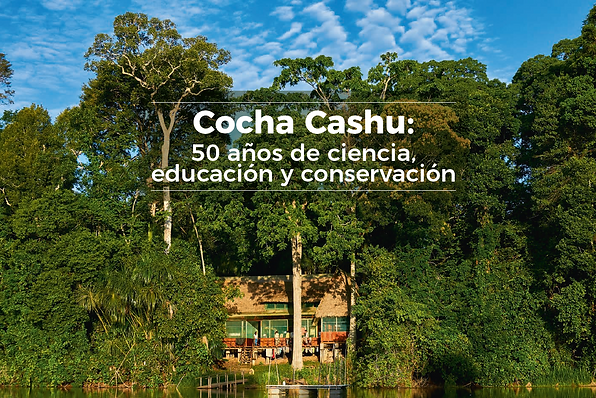
My Other Nature Books
Cocha Cashu: 50 años de ciencia, educación y conservación
Cocha Cashu Biological Station is an internationally renowned tropical ecology research centre, located on the shores of a lake in the heart of the magnificent Manu National Park, in the south-eastern Peruvian Amazon. It provides unparalleled opportunities to study ecological interactions in a vast rainforest region minimally impacted by humans, and serves as a critically important reference landscape for efforts to understand and mitigate the effects of human disturbance on biodiversity and ecosystem processes.
The Station is jointly managed by the National Service for Natural Protected Areas (SERNANP) and San Diego Zoo Global Peru, with the aim of strengthening its legacy as a centre of excellence for tropical research, increasing efforts to build national conservation capacity, integrating local communities, and supporting the management of Manu National Park.
In 2019, we celebrated the 50th anniversary of the founding of Cocha Cashu with a spectacular photo exhibition in Lima. This catalogue of images and texts (in Spanish) showcases science, education, and conservation at Cocha Cashu, as well as our deep pride in this unique place on Earth.
Published June 2019

Fieldwork Fail
Written and illustrated by Jim Jourdane, in collaboration with 25 scientists from around the world, Fieldwork Fail is the first non-academic book in which I was involved as editor. As recounted in my blog post about the experience, the theme of this book - "the messy side of science" - and Jim's wonderful illustrations, immediately appealed to me. In a previous life I was a field biologist myself so have been responsible for a few blunders of the sort described in these pages. I really enjoyed working with Jim on the English version and wholeheartedly recommend you purchase Fieldwork Fail here: there are also versions in Spanish, German, and French.
Published July 2017, ISBN: 978-2-9560045-1-6
One wildlife anthology. Three passionate nature writers. Nine engaging stories.
All Things Breathe Alike takes you on a journey through some of the most scenic and rich wildlife habitats in the world. From the humble chameleon in Tanzania to the regal gorilla in Rwanda, from the irrepressible giant otter in the Peruvian Amazon to the majestic elephant in Thailand's forests, and from the gentle sloth to the haughty harpy eagle in French Guiana, the insights and natural encounters in this family-friendly collection will charm and inspire anyone with a respect for, and love of, wildlife.
Available here.
Published February 2017. eBook. ISBN: 978-0-6480225-2-7 (ebk)
All Things Breathe Alike

Tito intiri Chavaropana
This illustrated bilingual conservation education book, in Matsigenka and Spanish, was written for the Matsigenka communities in and around Manu National Park, southeastern Peru. The main protagonists are a Matsigenka boy, Tito, acting as the voice of his community, and a giant otter, Chava, as flagship species of the aquatic environment in particular, and of the Protected Area as a whole.
The book explores the worlds and perspectives of each, blending Matsigenka folklore with natural history as well as key conservation issues. The book is co-authored by Gregorio Perez (a Matsigenka community leader) and Glenn Shepard (an anthropologist and expert on Matsigenka culture) and illustrated by a Cusco artist, Miguel Achahuanco. Our aim is to increase awareness of the giant otter amongst Matsigenka communities and to further conservation of this charismatic, endangered species.
Published November 2014
Giants of the Madre de Dios
A popular/scientific book co-authored with my husband, Giants of the Madre de Dios begins with a day in the life of a giant otter family. In Chapter Two, we accompany a disperser during the trials and tribulations of a year spent looking for a mate and home of its own. The third Chapter navigates the Madre de Dios River, from its source in the high Andes to the border with Bolivia, a river that links important giant otter populations and shapes the lives of gold miners, loggers, and indigenous peoples alike. Chapter Four describes a variety of conservation actions that have benefited the otters over the last decades. And in Chapter Five we outline challenges, and propose steps we can take, to further conservation of the species in southeastern Peru.
Published 2006, ISBN: 9972-2585-1-3




